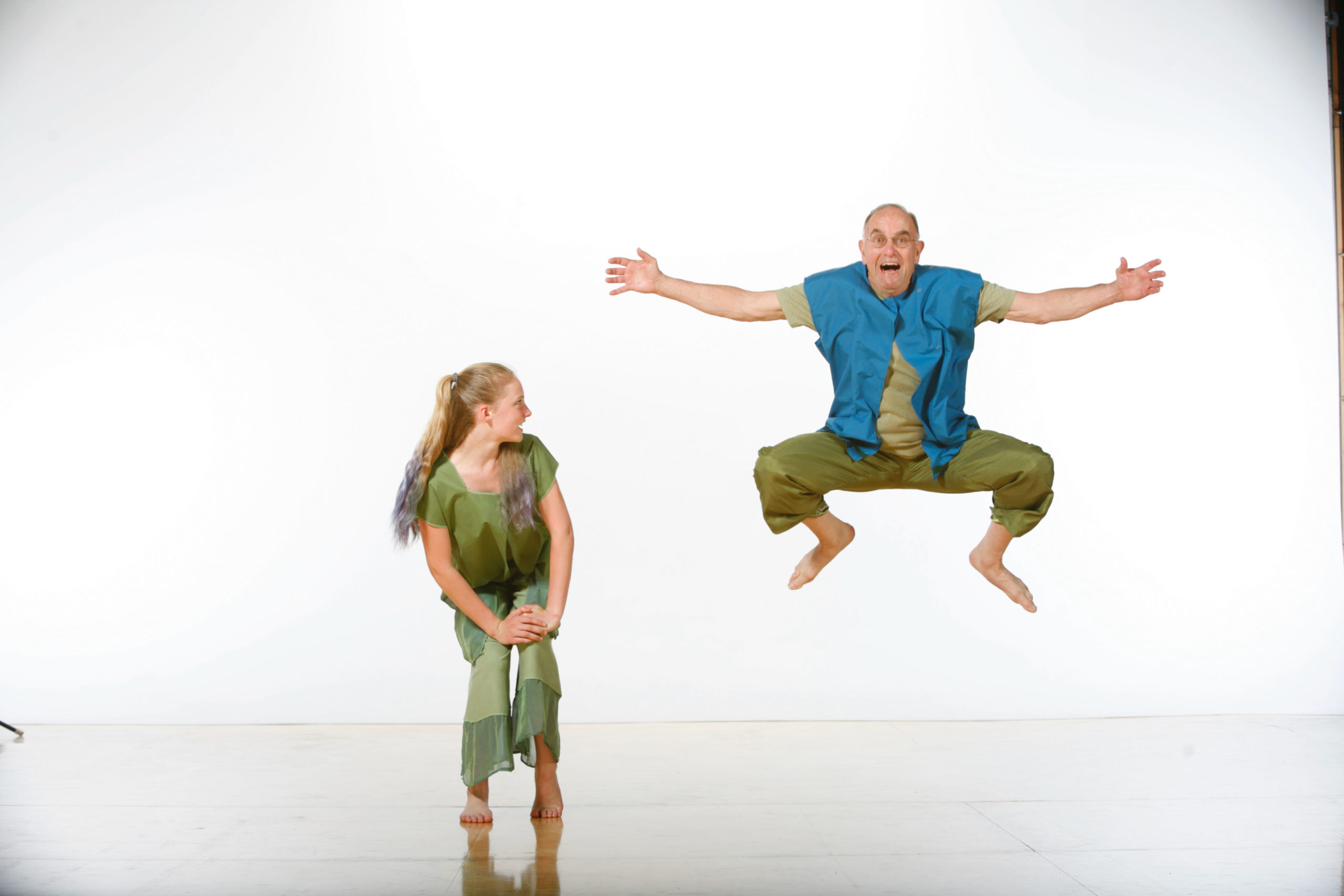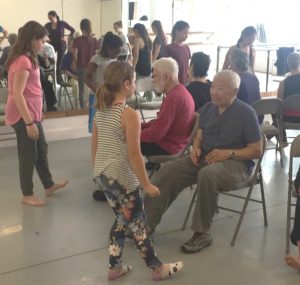
Photo by Matt Haber
[ID: Two dancers in green and blue costumes. Younger dancer is crouched down on the left with her head turned and looking at the dancer next to her. Elder dancer with Parkinson’s is mid jump with arms extended outwards, with a happy and excited expression on his face.]
I began teaching Dance for PD® in Oakland, in 2007. The classes are free and open to anyone who has Parkinson’s disease. Classes are taught with a live accompanist and structured like a typical dance class which offers a warm-up, center, and across-the-floor, ending with a dance combination. No prior dance experience is required. Unlike activities designed for therapeutic outcomes that bring patients into clinical settings, Dance for PD®, a program of the Mark Morris Dance Group, brings dancers with Parkinson’s into the dance studio. There, they have an opportunity to explore dynamic qualities, reference spacial landmarks, and develop ensemble experiences through imagery and musicality. It is a dance program crafted specifically for this special population.

[ID: Two dancers in green and blue flowing costumes. Elder dancer with Parkinson’s is walking forward looking straight at the camera. Younger dancer is behind her, peering around to look at her.]
Parkinson’s disease is a degenerative disease which is idiopathic and has no known cure. It affects the motor system which can manifest in stiffness, festination, bradykinesia, and/or tremor. It might seem strange that dance classes are offered to those who suffer from a movement disorder. Dance for PD® is now offered in 25 countries around the world and each Dance for PD® program uniquely addresses the interests and specialties of the teacher and the region. In my own classes, I see how the tools and techniques that dancers use can be extremely helpful for those living with Parkinson’s disease. In particular, imagery and musicality are very effective. When I first started teaching, I would say, “Let’s turn to the right,” but quickly found that it could be challenging for some to move their legs and shift their weight. Changing my tactic, I said, “Look at the butterfly and watch it flutter across the moon,” this imagery somehow unlocks the dancer within, and I see them turn with ease and grace.
In 2009, I started the PEACE Project in order to provide opportunities for dancers with Parkinson’s to perform with my intergenerational company dNaga. It was a way for those dancers who had been taking class to use their acquired dance skills and experience the thrill of being part of a production. I was also interested in learning more about the experience of having Parkinson’s disease and how one could find peace despite grappling with this continuously changing condition. This inquiry led me on a narrative medicine journey that manifested in the creation of several dances as well as a book, PEACE About Life: Dancing with Parkinson’s.
As part of my artistic process, I collect interviews around a specific subject. One such subject has been centered on diagnosis. Many people, after being diagnosed, look back on their experience and realize that there were telltale signs of motor impairment that they may have noticed early on. Usually this pertained to impaired movement patterns, such as the one a dancer and registered nurse discovered when she found she had trouble whisking an egg. In the dance studio, the company (made up of people with and without Parkinson’s disease) listened to her story while we experimented on what it was like to become the egg that is whisked, gyrating and foaming, fried and finally eaten. The movement phrase, along with several others inspired by their stories of diagnosis and treatment, was part of the dance Shock.
In another interview, Jenifer Peale, a retired nutritionist remarked, “It is just so much easier to say ‘I love you’ to people. I wonder why that is? It’s like being stripped down a bit, like an onion peels off. When you’ve gotten a few layers peeled off of you, by virtue of learning you have Parkinson’s, you’re a bit raw, but you’re also so much more exposed that it’s kind of the real you, or maybe the better you, or something underneath.” This interview turned into movement that was performed at the end of Brooklyn’s PEACE, where a dancer stands downstage left as she gestures the peeling off of one layer at a time. A group of dancers swirl in the shape of a lotus flower behind her. As the dance comes to an end, they enfold her into the center of the flower and together they rise, stretch, and bloom out of the mud, sending love out through the theater walls, across the city and state and all across the world.

[ID: Elder dancers with Parkinson’s are sitting on chairs in a circle facing outwards. Younger tween dancers are on the outside of the circle facing them, dancing together.]
We have employed this process of listening to interviews, building movement phrases and then transforming them into evening-length works for over a decade. The dances are powerful because the work acknowledges the difficulty of the disease but also celebrates the resiliency and tenacity of the participants. As people with Parkinson’s disease experience some loss in ability, I understand that selecting imagery and music that speaks to their maturity, life experience, and dignity is important. At the same time, part of my artistic expression is tied to the notion of play.
Bringing together youth to work with people with Parkinson’s has been a key component in introducing a sense of whimsy to what can be a heavy subject. I soon found that despite the age difference, both groups were dealing with some kind of change. Whether it be graduating from middle school or college, getting married, having children, breaking up, or dealing with a health issue, we are always adapting to life’s changing circumstances. The young people learn by watching the elders, and in turn the elders are energized by the youth. Together, we have managed to create a sense of belonging through dance, among ever-changing circumstances.
This article appeared in the Fall 2022 issue of In Dance.


